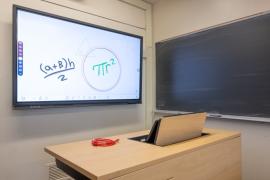Introducing Two New Technology Pilots
As teaching technology is constantly evolving, DCS always has it's finger on the pulse of emerging trends to ensure we are providing the most useful tools to our instructors. Our staff researches new technology and tests out the most promising. If we think a particular tool might warrant inclusion in our classrooms, we often pilot them in select spaces to learn more about their viability. This semester we began piloting two new technologies in Rutgers-New Brunswick classrooms: interactive displays and USB-C.
Interactive Displays are monitors that have touch capability and built-in apps that facilitate on-screen writing and control. Using these apps, faculty can show students class material while annotating over the screen, turn the screen into a whiteboard on which they can write, and - in some rooms - even control the computer through touch. This allows students to look to one place to view both the instructor and the content they are discussing. We've installed Interactive Displays in three different types of classrooms, to learn more about how they might be effectively used. Two seminar rooms - Hickman Hall Room 206 and Rutgers Academic Building 2150 - have displays that allow the instructor to annotate at the front of the room. Tillett Hall Room 204, an Active Learning Classroom, has six Interactive Displays. Students can use the display at their table to work in groups by writing on the screen. Finally, Richard Weeks Hall Room 105, an auditorium, has an Interactive Display which may be written on and then projected on to the room's large screen so the instructor can annotate at the room's front while students can see their writing from anywhere in the room.
 USB-C has become an increasingly common way to connect various devices like computers, phones, and tablets. In a classroom setting, it can be used to access files or project from a personal device. We have added USB-C in three spaces to learn more about their benefit. In Rutgers Academic Building Room 4400 and 4450, the collaborative student tables include USB-C cables. Students can connect their personal device - laptop, phone, or tablets - to those cables to display them on their table's monitor. In NJ Institute of Food Nutrition and Health Room 101, the Digital Classroom Podium has two USB-C ports. One - labelled "Data" - may be used to plug in thumb drives and access files. The other - labelled "Video" - may be used to project from a personal devices, such as a laptop, phone, or tablet. To connect the device, use the USB-C cable kept in the podium's side drawer.
USB-C has become an increasingly common way to connect various devices like computers, phones, and tablets. In a classroom setting, it can be used to access files or project from a personal device. We have added USB-C in three spaces to learn more about their benefit. In Rutgers Academic Building Room 4400 and 4450, the collaborative student tables include USB-C cables. Students can connect their personal device - laptop, phone, or tablets - to those cables to display them on their table's monitor. In NJ Institute of Food Nutrition and Health Room 101, the Digital Classroom Podium has two USB-C ports. One - labelled "Data" - may be used to plug in thumb drives and access files. The other - labelled "Video" - may be used to project from a personal devices, such as a laptop, phone, or tablet. To connect the device, use the USB-C cable kept in the podium's side drawer.
To learn more about these and past pilots, visit the DCS Pilots page.
